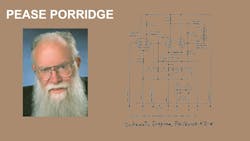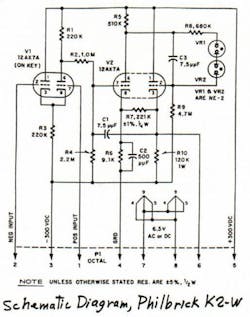The K2-W was not the first modern general-purpose operational amplifier. Loebe Julie's 1942 amplifier came earlier and had some real advantages. But the Julie amplifier didn't offer much gain, even after adding positive feedback. It didn't have much output power either, although a healthy cathode-follower output could easily be added. (See www.national.com/rap/vacuumtubes/html.)
The K2-W wasn't as powerful as either the M-IX Gun Director op amp or the Nike Ajax amplifier. But those drew four times as much power and featured a full-output frequency only out to ~100 Hz. They also required five regulated power supplies. (See these at the Web site.) But from 1951 to 1971, the K2-W at $22 was one of the best, lowest-cost op amps you could buy.
Specs: Voltage gain was 20,000 typical, and 10,000 minimum, for a ±50-V swing into a 50-kΩ load. Not wonderful, yet not terrible.
Frequency response: 300 kHz for unity gain, which is adequate for a low-power op amp. Also, its full output to 50 kHz was 100 times better than the Ajax or M-IX.
Input bias current: Philbrick bought good 12AX7s to run at 150 V Vpk (V-plate-to-kathode) at 300 µA, without gassing up. So, the grid current was a minuscule 10-8 amperes. Wow, 10 nanoamperes! In monolithic terms, that means any op amp better than an LM324 was probably about as good as a K2-W. In 1971, the LM308 finally beat that, but just barely.
How about Vos? It was guaranteed to be -1.5 V (design center) ±0.25 V dc typical, ±0.5 V max. No, I'm not kidding. The K2-W's offset arose from the obvious imbalance at the output of the first stage driving to the second stage. To keep life simple, the offset was allowed to be one-sided, so a single 2.6-V mercury battery could be applied via a 0.5-MΩ pot to cancel out Vos. Back then, that was acceptable. For inverting amplifiers, a fixed voltage divider fed the pot. Obviously, if the K2-W's Vos stayed inside 50 mV after you trimmed it, that's comparable to a ±10-V op amp keeping its Vos inside 10 mV. It took a while for solid-state amplifiers to beat that consistently.
Output power: ±1 mA into a 50-kΩ load. Obviously, high impedances were the rule in analog computing in those days! The K2-W could drive 20 1-MΩ loads—at its output, pin 6.
CMRR? Oh, there was never a spec on that. The K2-W had a guaranteed spec of ±50 V of common-mode range, but no spec on CMRR. When I measure it, I bet I'll see 33 dB. The Julie amplifier would beat it by 35 dB, due to its balanced design.
Why was the K2-W so popular? It was compact and modular. You could easily plug it in, unplug it, and swap. Plus, it was cheap at $22. (Remember, when the µA709 came out in 1968, the price was set at $25 for the cheap grade, and its Vos spec was 7.5 mV max.)
Also, the K2-W came with instructions. The 28-page Octal Applications Manual showed about 100 ways to use it. I've always said, if Philbrick hadn't shown everybody all the good things you could do with a cute, little op amp, Bob Widlar couldn't have given away his 709s. The Philbrick applications engineering guys made the whole industry happen. They gave it a good start. After solid-state amplifiers came along and became inexpensive, the industry boomed.
In future columns, I'll show some of the good things you could do with a K2-W. After all, it was ideal for George Philbrick's PANCELERIC analog computing—that is, computing in seconds, milliseconds, or any speed in between.
See associated figure.
Comments invited!
[email protected] —or:
Mail Stop D2597A, National Semiconductor
P.O. Box 58090, Santa Clara, CA 95052-8090
About the Author

Bob Pease
Bob obtained a BSEE from MIT in 1961 and was a staff scientist at National Semiconductor Corp., Santa Clara, CA, for many years. He was a well known and long time contributing editor to Electronic Design.
We also have a number of PDF eBooks by Bob that members can download from the Electronic Design Members Library.



